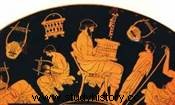 No, it's not that damn Charlemagne “who had this crazy idea, one day to invent the school ”. If the emperor encouraged its development, it has almost always existed, and above all has been reinvented many times to lead to our current educational system. From antiquity, human societies began to set up more or less elaborate means of transmitting knowledge and know-how.
No, it's not that damn Charlemagne “who had this crazy idea, one day to invent the school ”. If the emperor encouraged its development, it has almost always existed, and above all has been reinvented many times to lead to our current educational system. From antiquity, human societies began to set up more or less elaborate means of transmitting knowledge and know-how.
Teaching in antiquity
In ancient Egypt, education was essentially limited to inculcating the common script, the hieratic. The elite, a tiny minority therefore, who were destined for religious or administrative functions, were initiated into the mysteries of hieroglyphs. A long apprenticeship that guaranteed a high social position. In ancient Greece, education reached a first high degree of sophistication. In addition to writing, new disciplines are added, such as literature, war or sport. The principle is to harmoniously combine physical and intellectual development.
 Here again, it is young people from aristocratic families who benefit from this education, provided at home by masters or in the city gymnasium. In ancient Rome, the training of elites was largely inspired by the Greek example. Moreover, rich patrician families most of the time resorted to Greek slaves to educate their male offspring. In the Roman Republic, it was just as important to know how to handle the military art as the art of rhetoric...
Here again, it is young people from aristocratic families who benefit from this education, provided at home by masters or in the city gymnasium. In ancient Rome, the training of elites was largely inspired by the Greek example. Moreover, rich patrician families most of the time resorted to Greek slaves to educate their male offspring. In the Roman Republic, it was just as important to know how to handle the military art as the art of rhetoric...
School, by Charlemagne...
With the fall of the Roman Empire, education fell into disuse. Under the Merovingians, places to learn reading, writing and arithmetic became very rare, and the religious and political elites were most of the time completely illiterate. It is this situation that saddens Charlemagne, himself illiterate, and who would have great need of well-trained executives to administer his gigantic empire. It is one of his closest advisers, the English monk Alcuin, who will take care of remedying this situation. In charge of the education of the young nobles of the palace of Aix-la-Chapelle, the first "Minister of Public Instruction" rationalizes education. Grammar, rhetoric, calculation, astronomy… are organized into subjects. Throughout the empire, the clergy are ordered to open schools on the model of the capital. This voluntarism will greatly contribute to the cultural renewal of the Carolingian “renaissance”.
 In the 12th century, the declining monastic schools gave way to the first universities, such as that of Paris, founded in 1200 by Philippe Auguste, where law, art, medicine and of course theology are taught. Always stemming from religious institutions, colleges and high schools develop from the Renaissance. French is gradually replacing Latin. The royal power encourages these schools without ensuring either the organization or the financing, which reduces their number and their attendance. The French Revolution established for the first time the principle of secular and free education. Nevertheless, the school will remain the fact of religious education until the Third Republic.
In the 12th century, the declining monastic schools gave way to the first universities, such as that of Paris, founded in 1200 by Philippe Auguste, where law, art, medicine and of course theology are taught. Always stemming from religious institutions, colleges and high schools develop from the Renaissance. French is gradually replacing Latin. The royal power encourages these schools without ensuring either the organization or the financing, which reduces their number and their attendance. The French Revolution established for the first time the principle of secular and free education. Nevertheless, the school will remain the fact of religious education until the Third Republic.
… to Jules Ferry
During the 19th century, several governments tried to organize primary education. In 1850, the Falloux law requires all municipalities to have a primary school financed by the State and which coexists with private religious schools. It will be the Ferry laws of March 1882 which will make primary school compulsory from 6 to 13 years old, free and secular. After the Second World War, secondary education in turn became free, and in 1959 compulsory until the age of 16. Finally, diversity became widespread in 1976 with the Haby law.
While we cannot strictly speaking invent the school, we do know who invented and reinvented the reform of education:in this case, little nearly all ministers of education for fifty years. Rarely to the benefit of the quality and efficiency of the school...
To go further
- History of the school:Masters and pupils from Charlemagne to Jules Ferry, by Pierre Giolitto. Imago, 2003.
- The Most Beautiful History of the School, by Alain Boissinot and Luc Ferry. Laffont, 2017.
